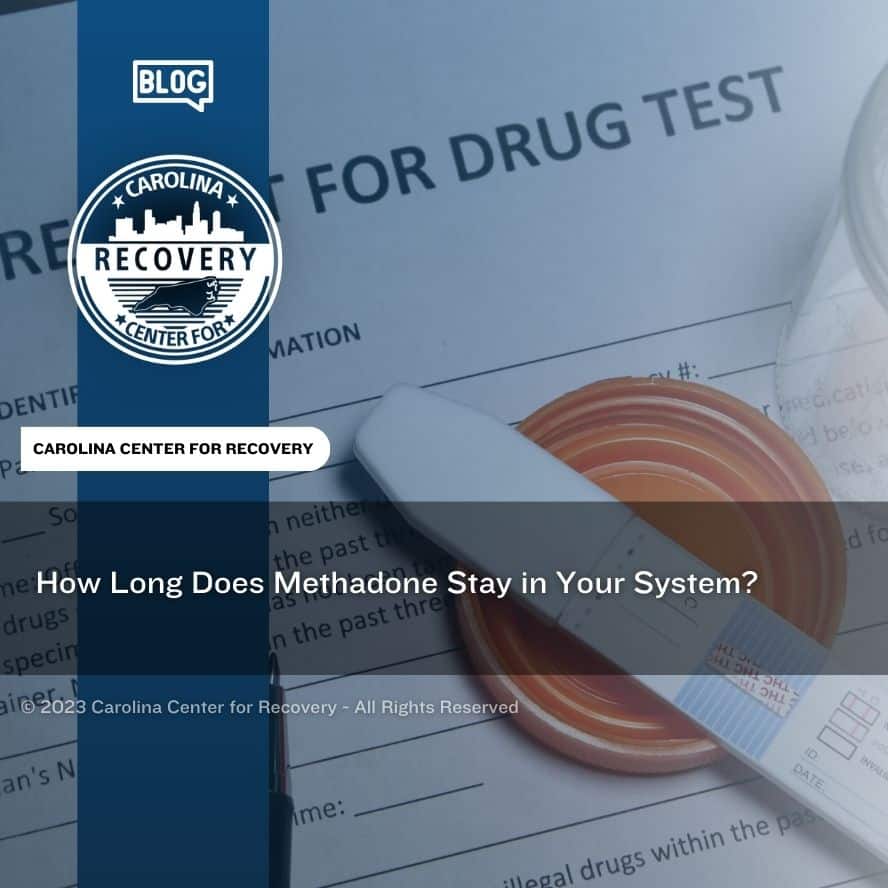How Long Does Methadone Stay in Your System?

Medically Verified: 2/1/24
Medical Reviewer
Chief Editor

All of the information on this page has been reviewed and verified by a certified addiction professional.
Methadone is a long-acting opioid that is primarily used to treat opioid use disorder.[1] It works by targeting opioid receptors in the brain to limit withdrawal symptoms and prevent cravings during early recovery from opioid addiction. While methadone can be incredibly effective in managing opioid use disorder, it is possible to abuse it.
When abused in large doses, methadone can produce a euphoric and drowsy high. After repeated abuse, it is possible to develop an addiction. If you or a loved one suffers from methadone addiction, a drug and alcohol rehab center can help you regain control over your life.
Methadone has a long half-life of 8 to 60 hours, it can remain in your body for up to 12 days.[2] Some drug tests may detect methadone for even longer periods of time.
How Long Does Methadone Remain in Your System?
When you consume methadone, it travels from your bloodstream into your liver. Your liver breaks methadone down into a metabolite known as 2-ethylidene-1, 5-dimethyl-3, 3-diphenyl pyrrolidine (EDDP).[3] Eventually, this metabolite will be eliminated from your body via urine.
Since methadone is a long-acting opioid, it can take a while for your system to flush it out. The half-life of methadone is somewhere between 8 to 60 hours, depending on several factors including the dose you typically take and how fast your metabolism is.[2]
It takes about 4 to 5 half-lives for your body to eliminate a substance, so methadone can remain in your system for up to 12 days.
Factors that Affect How Long Methadone Stays in Your System
Exactly how long methadone stays in your system depends on a variety of factors, including the dose you consume, how long you’ve been abusing it, and the rate of your metabolism. If you have been abusing methadone for a couple of years, it will stay in your body longer than if you were a first-time user.
Other factors that affect how long methadone stays in your system include:
- Your overall physical health
- The rate of your metabolism
- The health of your liver
- Your age and weight
- The presence of other substances in your system
- The dose of methadone you use
- The frequency at which you consume methadone
People with a higher body weight might take longer to eliminate methadone from their system, as the substance can be retained in fatty tissues. Additionally, if you have any liver conditions it might take longer for methadone to be flushed from your system, as it is metabolized by your liver.
How Long is Methadone Detected on Drug Tests?
If you are looking to start a new job or get into a trade school, you might have to pass a drug test to be accepted.
Each type of drug test has a different window of detection. While individual factors can affect how long methadone stays in your system, estimated drug test detection times are as follows:
Urine
Urine tests are the most commonly used drug tests when it comes to detecting methadone in a person’s system. These tests can tell if you have abused methadone for up to two weeks after your last dose.
Saliva
Saliva drug tests look for metabolites of methadone left behind in your saliva. Because this is the first place that methadone is metabolized, saliva drug tests provide a shorter window of detection. These tests can only detect methadone for a couple of days after you last used it.
Blood
Blood tests are not as commonly used because they are invasive and provide a short window of detection. They might be used in a hospital setting to determine if methadone is contributing to the symptoms you are experiencing.
Blood tests can detect methadone for 2 to 3 days after your last dose.
Hair
Hair tests are the most reliable drug test available, however, they are not used frequently because they can be expensive to send off to the lab. Hair tests can detect methadone in your system for up to 90 days after your last dose.
Getting Methadone Out of Your System
The only way to get methadone out of your system is to stop taking it and let your body do it’s job. However, abruptly stopping methadone can lead to severe withdrawal symptoms, such as nausea, vomiting, muscle aches, anxiety, insomnia, and cravings.
It’s essential to work closely with a healthcare professional to create a tapering schedule that suits your individual needs and minimizes discomfort. By gradually reducing your methadone dose, you can avoid withdrawal symptoms and detox safely.
Find Help for Methadone Abuse and Addiction
If you or a loved one struggles with methadone addiction, a drug rehab center can help you achieve long-term sobriety. At Carolina Center for Recovery, we understand that everyone is different, so we use individualized treatment planning to ensure each client has access to services that work for them.
To learn more about our methadone addiction treatment program, contact us today.
References:
- The Substance Abuse and Mental Health Services Administration (SAMHSA): What is Methadone, Retrieved December 2023 From https://www.samhsa.gov/medications-substance-use-disorders/medications-counseling-related-conditions/methadone
- The Food and Drug Administration (FDA): Methadone Label, Retrieved December 2023 From https://www.accessdata.fda.gov/drugsatfda_docs/label/2018/006134s045lbl.pdf
- The National Library of Medicine (NLM): Methadone–metabolism, pharmacokinetics and interactions, Retrieved December 2023 From https://pubmed.ncbi.nlm.nih.gov/15501692/

